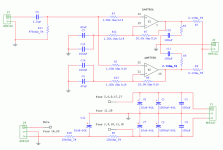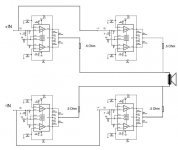Ok, now that I've got my first chipamp under my belt, I may start another project, and I'm looking for peoples opinion.
I'm looking to drive some Adire Kit281 speakers. They use two 8" drivers with a 4 ohm load, and I will be using an active crossover. I've read that the 281s are quite power hungry (88 SPL eff).
So, with that said, I'm thinking I may try monoblocks based on the LM4780 or LM3886, using BrianGTs kits, and Carlosfm's snubberized setup.
I want power, lots of it.
Here are some options (Brian has given the thumbs up on these options, so, I'm not discounting his advice, just would like others input):
1. LM4780, squeezing as much power out as possible
2. Two LM3886 in parallel per channel
3. Three LM3886 in parallel per channel
4. Forget the use of chipamps (for woofers), and focus on a SS solution
Thanks for any and all input!
I'm looking to drive some Adire Kit281 speakers. They use two 8" drivers with a 4 ohm load, and I will be using an active crossover. I've read that the 281s are quite power hungry (88 SPL eff).
So, with that said, I'm thinking I may try monoblocks based on the LM4780 or LM3886, using BrianGTs kits, and Carlosfm's snubberized setup.
I want power, lots of it.
Here are some options (Brian has given the thumbs up on these options, so, I'm not discounting his advice, just would like others input):
1. LM4780, squeezing as much power out as possible
2. Two LM3886 in parallel per channel
3. Three LM3886 in parallel per channel
4. Forget the use of chipamps (for woofers), and focus on a SS solution
Thanks for any and all input!
you can parallel LM4780's til your heart's content -- (the disadvantage of paralleling is that a buffer is required if you parallel more than a couple units.)
i just ordered prototype boards of the parallel amp (Paraclone) -- with +/- 28V it should deliver about 75 watts to the load, and the heatsink won't be enormous (2.1 C/W). You can go to about +/-34V but this requires a huge heatsink or forced cooling.
i just ordered prototype boards of the parallel amp (Paraclone) -- with +/- 28V it should deliver about 75 watts to the load, and the heatsink won't be enormous (2.1 C/W). You can go to about +/-34V but this requires a huge heatsink or forced cooling.
Attachments
drfrink24 said:I built an LLC myself, maybe I need to build three monoblocks...
I am almost contemplating building an Active ox for the LLC with some 3886's to power it but i am almost leaning against that, and just build a pair of mini monitors that are actively crossed.
I am finishing my BPA (400W ?) not sure on what power.
It is built out of 8 Brian's 4570 boards - 4 boards for each side. Each board is paralleled internally with two 0.1 ohms and than I paralleled two of them. I am supplying balanced signal and each pole of the balanced signal is driving these two paralleled boards, and than they are bridged in the output.
First i taught that I do not need any extra resistors to parallel two boards, since they already have two 0.1 ohms on them, but that didn't work. I tried with another 0.1 for each board and that didn't work ether - the amp oscillate. So I ended up with 0.5 ohm for each paralleled board, and that works fine. I do not understand why is that, and any advise is appreciated.
The heat is tremendous. I have to redo the whole cooling concept. I had 4 boards on big 12 x 8 x 1 inch heat sink, and that wasn't enough. Now I am changing it to two of the same sinks for 4 boards.
In my tests the sound was really awesome. Very powerful and base was very low. It outperforms my 2 x 200 W Mosfet class AB amp, particularly in bass region.
This amp is intended to drive bass speakers that are difficult to drive - 4 ohms and 87 dB sensitivity, similar to your Adire. I still have to finish and redo my amp to give you better answer, but so far just as a test it is very promising.
It is built out of 8 Brian's 4570 boards - 4 boards for each side. Each board is paralleled internally with two 0.1 ohms and than I paralleled two of them. I am supplying balanced signal and each pole of the balanced signal is driving these two paralleled boards, and than they are bridged in the output.
First i taught that I do not need any extra resistors to parallel two boards, since they already have two 0.1 ohms on them, but that didn't work. I tried with another 0.1 for each board and that didn't work ether - the amp oscillate. So I ended up with 0.5 ohm for each paralleled board, and that works fine. I do not understand why is that, and any advise is appreciated.
The heat is tremendous. I have to redo the whole cooling concept. I had 4 boards on big 12 x 8 x 1 inch heat sink, and that wasn't enough. Now I am changing it to two of the same sinks for 4 boards.
In my tests the sound was really awesome. Very powerful and base was very low. It outperforms my 2 x 200 W Mosfet class AB amp, particularly in bass region.
This amp is intended to drive bass speakers that are difficult to drive - 4 ohms and 87 dB sensitivity, similar to your Adire. I still have to finish and redo my amp to give you better answer, but so far just as a test it is very promising.
AR2 said:I am finishing my BPA (400W ?) not sure on what power.
It is built out of 8 Brian's 4570 boards - 4 boards for each side. Each board is paralleled internally with two 0.1 ohms and than I paralleled two of them. I am supplying balanced signal and each pole of the balanced signal is driving these two paralleled boards, and than they are bridged in the output.
First i taught that I do not need any extra resistors to parallel two boards, since they already have two 0.1 ohms on them, but that didn't work. I tried with another 0.1 for each board and that didn't work ether - the amp oscillate. So I ended up with 0.5 ohm for each paralleled board, and that works fine. I do not understand why is that, and any advise is appreciated.
The heat is tremendous. I have to redo the whole cooling concept. I had 4 boards on big 12 x 8 x 1 inch heat sink, and that wasn't enough. Now I am changing it to two of the same sinks for 4 boards.
In my tests the sound was really awesome. Very powerful and base was very low. It outperforms my 2 x 200 W Mosfet class AB amp, particularly in bass region.
This amp is intended to drive bass speakers that are difficult to drive - 4 ohms and 87 dB sensitivity, similar to your Adire. I still have to finish and redo my amp to give you better answer, but so far just as a test it is very promising.
reduce the supply voltage (if you can), remembe that the PDMAX for a bridged amplifier is 4 times that of a non-bridged design. my Bridgeclone uses a heat sink with C/W of ~1.6 and 100 lfm of forced air. the power dissipated by the chip, and not going into the load is:
Pdmax = (|Vcc|^2)/(2 *pi*pi*RL),
for bridged operation multiply pdmax by 4
the other reason for "heat" is that an oscillating amplifier consumes a lot of energy. layout consideration require great care even when you don't stess the amplifier.
you have some other problems as well, the 0.5 ohm resistor is consuming another R*(I^2) watts -- not a huge amount of power, but music you would otherwise be hearing. i think that I would look for other ways in which to compensate for the oscillation.
this is where a network analyzer comes in handy --
jackinnj said:
the other reason for "heat" is that an oscillating amplifier consumes a lot of energy. layout consideration require great care even when you don't stess the amplifier.
you have some other problems as well, the 0.5 ohm resistor is consuming another R*(I^2) watts -- not a huge amount of power, but music you would otherwise be hearing. i think that I would look for other ways in which to compensate for the oscillation.
this is where a network analyzer comes in handy --
Thank you jackinnj for the quick answer. I do not like the fact that I have to add more resistance to the output, but it was an attempt to make it work in the first place.
Since I am still in the testing phase, could you share what other ways to fix the oscillations you would advise. Would that be servo on each chip?
My idea behind the design was that if each Brian's board is working well - which it does without servos, than adding them all together will be fine. I have to agree with you - not as easy as I taught.
Your advise is greatly appreciated
AR2
drfrink24 said:Let me do a favor for you, and move this to a new post.
Sorry drfrink24 if I hijacked your thread, I taught it is related and helpful.
AR2 said:
Sorry drfrink24 if I hijacked your thread, I taught it is related and helpful.
No, by all means, its VERY helpful, however, I thought with the title of my thread, it may not be seen by as many people.
Upupa Epops said:....Your schematic is uncorrect cos every amps are noninverting....
Input is balanced.

- Status
- This old topic is closed. If you want to reopen this topic, contact a moderator using the "Report Post" button.
- Home
- Amplifiers
- Chip Amps
- LM4780/LM3886 to power large speakers

